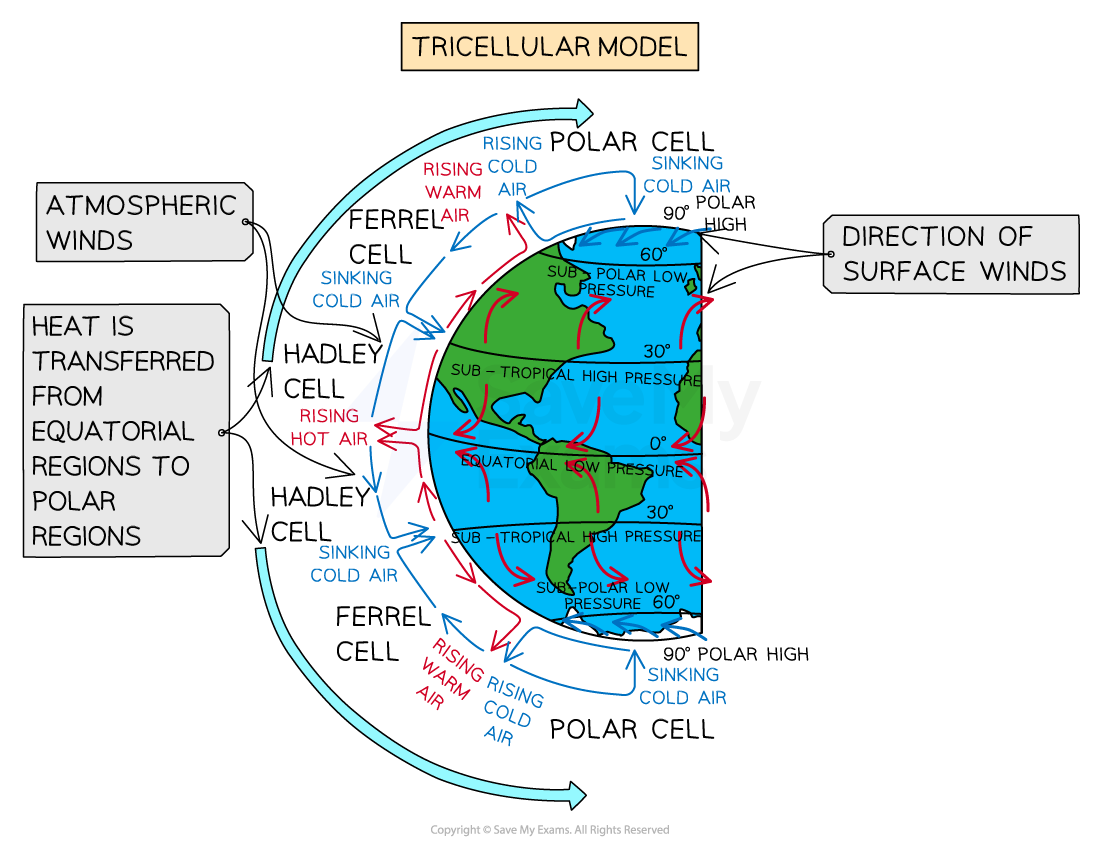Weather & Climate
- Climate refers to the long-term average of weather conditions in a particular region or location
- It describes the overall patterns, trends, and variations in temperature, precipitation, humidity, wind, and other atmospheric factors over a significant period (typically 30 years or more)
- Climate is influenced by various factors such as solar radiation, atmospheric circulation patterns, ocean currents, land features, and greenhouse gas concentrations
- Weather, on the other hand, refers to the current state of the atmosphere at a specific time and place
- It includes short-term variations in temperature, humidity, cloud cover, precipitation, wind speed, and other atmospheric conditions
- Weather conditions can change rapidly and are often described in terms of temperature, humidity, precipitation type, wind direction, and speed
- While climate provides a broader perspective on long-term atmospheric behaviour, weather is more concerned with immediate atmospheric conditions and forecasts
- Understanding the difference between climate and weather is crucial for analysing long-term climate trends, predicting short-term weather events, and assessing the impacts of climate change on weather patterns
Oceanic Circulatory Systems

Oceanic circulatory systems transport heat and energy around the world, affecting weather and climate
- Weather and climate are strongly influenced by oceanic circulatory systems, which play a vital role in regulating temperature, moisture distribution, and atmospheric dynamics
- These circulatory systems, such as ocean currents and upwelling, have significant impacts on both regional and global scales
- Ocean currents, driven by factors like wind, temperature, and salinity gradients, redistribute heat across the Earth's surface
- Warm ocean currents carry heat from the tropics towards higher latitudes, moderating temperatures in coastal areas and influencing regional climates
- Cold ocean currents transport cold water from polar regions towards lower latitudes, resulting in cooler coastal temperatures and affecting the formation of coastal fog and marine ecosystems
- Upwelling occurs when cold, nutrient-rich water rises to the surface, primarily driven by wind that moves surface waters out the way, allowing deeper waters to rise up to replace them
- Upwelling brings deep, nutrient-rich waters to the surface, supporting abundant marine life and contributing to the productivity of fisheries in coastal areas
- El Niño and La Niña events, part of the El Niño-Southern Oscillation (ENSO) cycle, have significant impacts on global weather patterns
- El Niño events involve the warming of the central and eastern equatorial Pacific Ocean, causing shifts in atmospheric circulation and leading to droughts, floods, and other extreme weather events in various parts of the world
- La Niña events, on the other hand, involve cooler-than-average sea surface temperatures and can result in contrasting weather patterns
- The Gulf Stream, a strong warm ocean current in the Atlantic Ocean, plays a critical role in shaping weather and climate in the North Atlantic region
- It helps transport warm water and influences the temperature and moisture content of the air, affecting weather patterns and storm development
- Oceanic circulatory systems also influence the distribution of moisture in the atmosphere
- Evaporation from warm ocean surfaces adds moisture to the air, which can lead to the formation of clouds, precipitation, and the development of storm systems
- Changes in oceanic circulatory systems, such as alterations in current strength or shifts in their paths, can have significant implications for regional and global climates
- These changes can result from natural variability, as well as long-term climate change driven by factors like greenhouse gas emissions
Atmospheric Circulatory Systems
- Weather and climate are also significantly influenced by atmospheric circulatory systems, which result in the movement of air masses, distribution of heat, and the formation of weather patterns
- These circulatory systems, such as global wind patterns, jet streams, and local wind systems, impact both daily weather conditions and long-term climate trends

Heat energy flow and surface winds can be explained using the tricellular model of atmospheric circulation
- Global wind patterns, such as the Hadley, Ferrel, and Polar cells, are large-scale circulations driven by the uneven heating of the Earth's surface
- These wind patterns help transport heat from the equator towards the poles, influencing the distribution of temperature and pressure on a global scale
- The jet streams are narrow, fast-flowing bands of winds in the upper troposphere and lower stratosphere
- They form as a result of the temperature differences between air masses and play a significant role in shaping weather patterns
- Local wind systems, such as sea breezes, land breezes, and mountain-valley breezes, are influenced by differential heating and cooling of land and water surfaces
- These winds can affect local weather conditions, especially in coastal and mountainous regions
- The Coriolis effect, caused by the Earth's rotation, influences the direction of winds and the formation of atmospheric circulation patterns
- It deflects air masses in the Northern Hemisphere to the right and in the Southern Hemisphere to the left, resulting in the characteristic curving paths of winds
- Understanding the interactions between atmospheric circulatory systems and weather/climate is crucial for meteorologists, climatologists, and weather forecasters
- By studying these circulatory systems, scientists can better predict and understand weather phenomena, assess climate patterns, and investigate the impacts of climate change on global and regional scales

